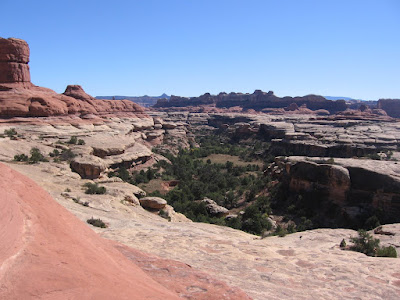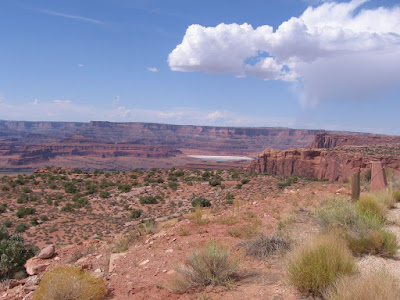 It is about 2.2 miles along this sandy 4WD road to the junction with Horse Canyon on the left. The Salt Creek route continues on the right to Peekaboo Springs and the not to be missed pictograph.
It is about 2.2 miles along this sandy 4WD road to the junction with Horse Canyon on the left. The Salt Creek route continues on the right to Peekaboo Springs and the not to be missed pictograph. I thought this arch was Paul Bunyan's Potty but it actually belongs to someone smaller and doesn't seem to have a name. Paul apparently has a two holer. It took me about 1:15 hours to get to this point. The canyon floor here is fairly dense with vegetation and there appears to be a project of reducing the invasive Tamarisk trees.
I thought this arch was Paul Bunyan's Potty but it actually belongs to someone smaller and doesn't seem to have a name. Paul apparently has a two holer. It took me about 1:15 hours to get to this point. The canyon floor here is fairly dense with vegetation and there appears to be a project of reducing the invasive Tamarisk trees.It is possible to get off the trail and down into the wash for a closer look. This area has a lot of alcoves and cave formations that look like possible ruins sites. The ruins sites in this area mostly appear to be small storage sites.
 About 15 minutes past the first arch there is a small storage ruin right at eye level along the sandy trail. These sites usually seem to be placed higher and are more hidden than this one.
About 15 minutes past the first arch there is a small storage ruin right at eye level along the sandy trail. These sites usually seem to be placed higher and are more hidden than this one.
The interpretive information at the Roadside Ruins site indicates that this region may have been used seasonally for farming but not so much for year round habitation.
 The Paul Bunyan Potty arch is looming just above the small storage ruin only a minute further away. There is a sign making the identification clear. Hiking past the Paul Bunyan arch toward Tower Ruin, both of the arches can be viewed at the same time.
The Paul Bunyan Potty arch is looming just above the small storage ruin only a minute further away. There is a sign making the identification clear. Hiking past the Paul Bunyan arch toward Tower Ruin, both of the arches can be viewed at the same time.
 There is a short side trail from the small loop parking area to get up under and get the clear sky view through the arch. It took me about 1:30 hours to get here hiking. This is a somewhat tiring route due to the sand.
There is a short side trail from the small loop parking area to get up under and get the clear sky view through the arch. It took me about 1:30 hours to get here hiking. This is a somewhat tiring route due to the sand.
 The Paul Bunyan Potty arch is looming just above the small storage ruin only a minute further away. There is a sign making the identification clear. Hiking past the Paul Bunyan arch toward Tower Ruin, both of the arches can be viewed at the same time.
The Paul Bunyan Potty arch is looming just above the small storage ruin only a minute further away. There is a sign making the identification clear. Hiking past the Paul Bunyan arch toward Tower Ruin, both of the arches can be viewed at the same time. There is a short side trail from the small loop parking area to get up under and get the clear sky view through the arch. It took me about 1:30 hours to get here hiking. This is a somewhat tiring route due to the sand.
There is a short side trail from the small loop parking area to get up under and get the clear sky view through the arch. It took me about 1:30 hours to get here hiking. This is a somewhat tiring route due to the sand.
I was always searching for a firmer surface to walk on. From the Paul Bunyan arch it is about 40 minutes further to get to Tower Ruin. My total hike was 4:10 hours for this 8 or 9 mile round trip.





 There is a pull over parking place on the west side of the road but there is not a sign. A trail leads down to Indian Creek and you have to find a place to step across the creek and then follow the trail to the right side of the canyon wall. Creek junctions like this one are a typical place to look for petroglyphs.
There is a pull over parking place on the west side of the road but there is not a sign. A trail leads down to Indian Creek and you have to find a place to step across the creek and then follow the trail to the right side of the canyon wall. Creek junctions like this one are a typical place to look for petroglyphs.




 It is part of an extensive network of trails that passes up and down on the carved rocks of this part of Canyonlands, giving long views from up above and passing through the desert environment and sometimes riparian areas down below.
It is part of an extensive network of trails that passes up and down on the carved rocks of this part of Canyonlands, giving long views from up above and passing through the desert environment and sometimes riparian areas down below.






 This route has a lot of water in the spring but is reasonably dry in the fall. I hiked in October from Peekaboo Springs back out to the Cave Springs area after starting from the Squaw Flat Campground trailhead and hiking the 5.0 miles to the Peekaboo pictograph panel.
This route has a lot of water in the spring but is reasonably dry in the fall. I hiked in October from Peekaboo Springs back out to the Cave Springs area after starting from the Squaw Flat Campground trailhead and hiking the 5.0 miles to the Peekaboo pictograph panel.




 The trailhead is just a little past the visitor center and is one of the first attractions a first time visitor would come across. In addition to the small ruin, this is also a botany trail, identifying nine of the common plants in this desert environment.
The trailhead is just a little past the visitor center and is one of the first attractions a first time visitor would come across. In addition to the small ruin, this is also a botany trail, identifying nine of the common plants in this desert environment.




 The first view area is about 150 yards up the trail. This view area is to the east of the Island in the Sky District of Canyonlands National Park and Dead Horse Point State Park.
The first view area is about 150 yards up the trail. This view area is to the east of the Island in the Sky District of Canyonlands National Park and Dead Horse Point State Park.





 The Wineglass Arch is visible from the road. There are some trail segments, but it is easy just to cross the open field to the base of the rock outcrop.
The Wineglass Arch is visible from the road. There are some trail segments, but it is easy just to cross the open field to the base of the rock outcrop. 

